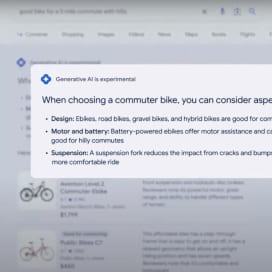Written by Fernando Maciá
Índice

Search engine optimization is a concept that seems to be in vogue. More and more companies are competing for similar market niches. This translates into fierce competition for the highest search engine rankings in as many categories as possible.
In recent years, webmasters and companies specialized in web optimization have taken advantage of certain weaknesses in search engine indexing algorithms to obtain higher rankings than their own content would allow them. Search engines have defended themselves against these practices by perfecting their algorithms, so that a certain “trick” that at a certain time may have given a website a competitive advantage, has later become a reason to be expelled from the search engine’s index.
Whether you optimize your web content yourself to obtain better rankings in search engines, or you have hired a specialized company, you should take into account the following five aspects to know if your website is compliant or if your traffic and positioning are at risk. Failure to comply with these rules “may affect the site’s ranking within MSN Search and may cause your site to be removed from the MSN Searchindex,” according to MSN Search. Google specifies that “these quality guidelines cover the most common forms of deceptive or manipulative behavior. However, Google may react negatively to other deceptive practices”. For this reason, you may want to review your application of certain recommendations that you may have seen in some specialized forums or the work done by the company to whom you entrusted this work.
1. Hidden text
Hidden text is text that is not displayed in the browser but is seen by search engines when they visit your website. Some webmasters and SEO companies include blocks of hidden code where they insert search terms and links that the user does not see, to improve search engine rankings.
MSN Search specifies that “the use of hidden text or links is not recommended”. And it recommends “only using links and text that users can see”. Google recommends “avoiding hidden text or links”.
If you have not optimized your web site yourself and want to check if your pages comply with this recommendation, open Microsoft Explorer and from the View menu, select Source Code. A new window with code will open. In the Edit menu, click on Search. Enter “<noscript>” in the search text box. Then try searching for “<noframes>”. If you find either of these two expressions on your page, look at the lines of code below. If you find links to domains other than your own or expressions and phrases other than your activity, such as “<a href=”http://www.otrodominio.com”>Another _fcksavedurl=””http://www.otrodominio.com”>Other” _fcksavedurl=””http://www.otrodominio.com”>Other” _fcksavedurl=””http://www.otrodominio.com”>Other” activity</a>”It is quite possible that your page contains hidden text and links. It is also possible that your website is being used to improve the positioning of other websites, or of the company that was in charge of its optimization.
The most beneficial links for your website are those that have to do with your own activity and also have a good positioning on the Internet. MSN Search advises to avoid “using techniques to artificially increase the number of links to your site, such as a group of links”.
Google warns, “Do not participate in linking schemes designed to increase the ranking or PageRank value of your site. In particular, avoid links to the creators of fraudulent sites or undesirable neighborhoods on the Web, as your own ranking could be negatively affected by such links.”
If you want to check which sites have links to yours, open your browser and go to a search engine. Enter link:www.susitio.com (or .es, etc.). The search engine will return a results page with web pages containing links to your domain. Look at the domains and open those that seem strange to you. If one of them shows a page full of links, you will know that your site is on a link farm. It is also possible that you see pages that have nothing to do with your activity and that, when you open them, you cannot even see the link on those pages. This means that these pages contain hidden links, probably unbeknownst to their owners, pointing to your site, as you can see as we have explained in point 1.
3. Irrelevant words
If you do the optimization of your website yourself, do not be tempted to include popular words in Internet searches: “sex”, “porn”; and do not play around with including brand names or names of competing companies. In the first case, unless your website commercializes this type of content, do you really believe that someone interested in searches about “sex” can become your customer? In the second case, you are simply doing something illegal.
In this regard, MSN Search warns against “loading pages with irrelevant words in an attempt to increase the keyword density of a page. This includes the accumulation of ALT tags that users are unlikely to see.”
Google is blunt: “Don’t load pages with irrelevant words.”
If a specialized company has taken care of the optimization, go back to the hidden text blocks as explained in point 1 and see which words are included. If you find expressions that have nothing to do with your activity, your website is probably being used to position other websites, perhaps even those of your competitors. If you find expressions such as search engine optimization, search engine submission or similar, then it is possible that the company you commissioned to optimize your site is using your site for its own benefit.
4. Concealment or elusive redirects
This is to host redirection pages that contain a key concept as a subdomain. These top domains become very popular through hidden links scattered among numerous websites. Sometimes, a subdomain such as keyconcept.key.domains.com is used to host over-optimized gateways or redirects.
Google warns, “Do not use cloaking or elusive redirects.”
You can check if your website uses this technique by rechecking the hidden code. Look for links of the type <a href=”http://miconceptoclave.dominiosospechoso.net (or .com, .biz, etc.)”>My key concept</a>. If you find such a link, copy the URL (http://miconceptoclave.dominiosospechoso.net) and paste it into your browser’s address box. Press Enter and check if that address returns you to your own website. If so, the company that optimized your site probably applied this technique prohibited by search engines to artificially increase the popularity of your site.
5. Doorway Pages
It consists of hosting several entry pages that are individually optimized for each search engine and different from the ones the user sees.Google advises to “avoid “doorway” pages created exclusively for search engines or other “homemade” methods, such as affiliate programs with little or no original content”.
We do not recommend that you apply this technique as it is discouraged by search engines. If it is a company that did the optimization, try loading the name of your entry page plus a number to see if there are other doorway pages. For example, if your default page is called index.htm, try loading index2.htm. If a page similar to your default page loads, then you may be in this risk group.
Conclusion
It is likely that at some point, you have come across sites on the Internet that recommended this or that trick. It can be tempting to apply techniques that exploit search engine weaknesses or customer ignorance to increase the search engine visibility of certain websites. Consider whether it is worth the risk of being removed from the MSN Search or Google index. Evaluate the effect it would have on your web traffic.
We recommend the use of correct code, generation of interesting content, proactive search for partners and alliances to get quality inbound links, constant updating of the pages and a logical structuring of each page in terms of usability as well as the entire website in terms of navigability. Apply an ethical positioning of your website. Search engines will reward you with quality traffic and your customers will reward you with results.



